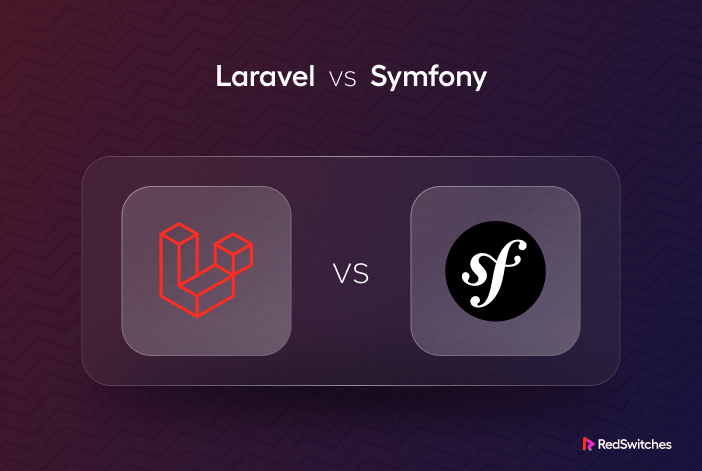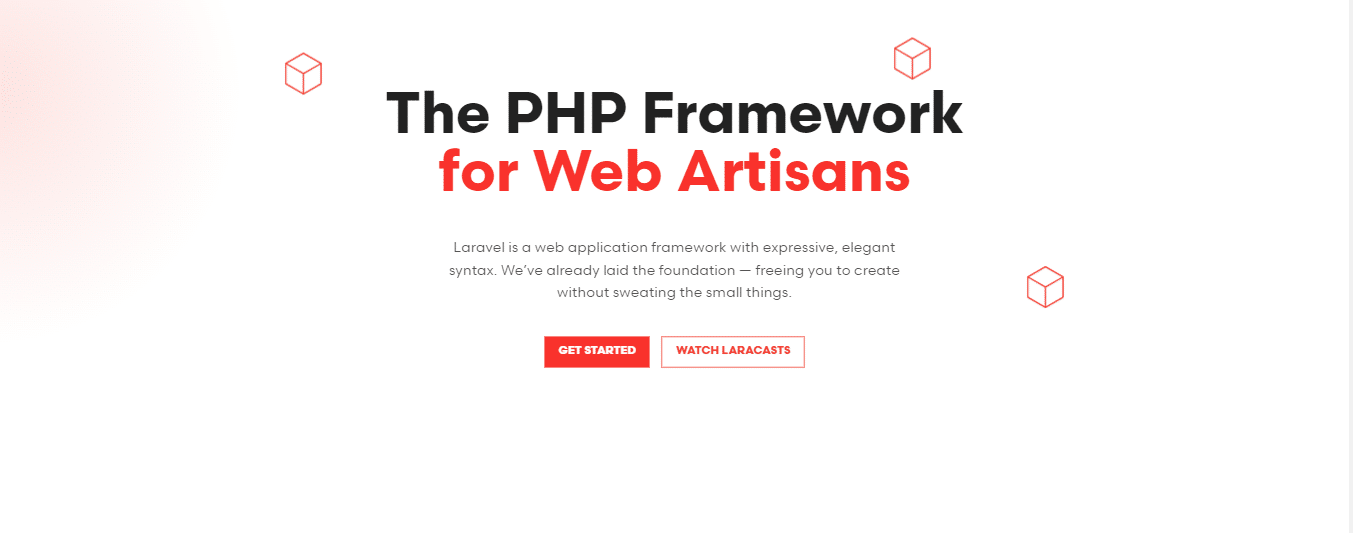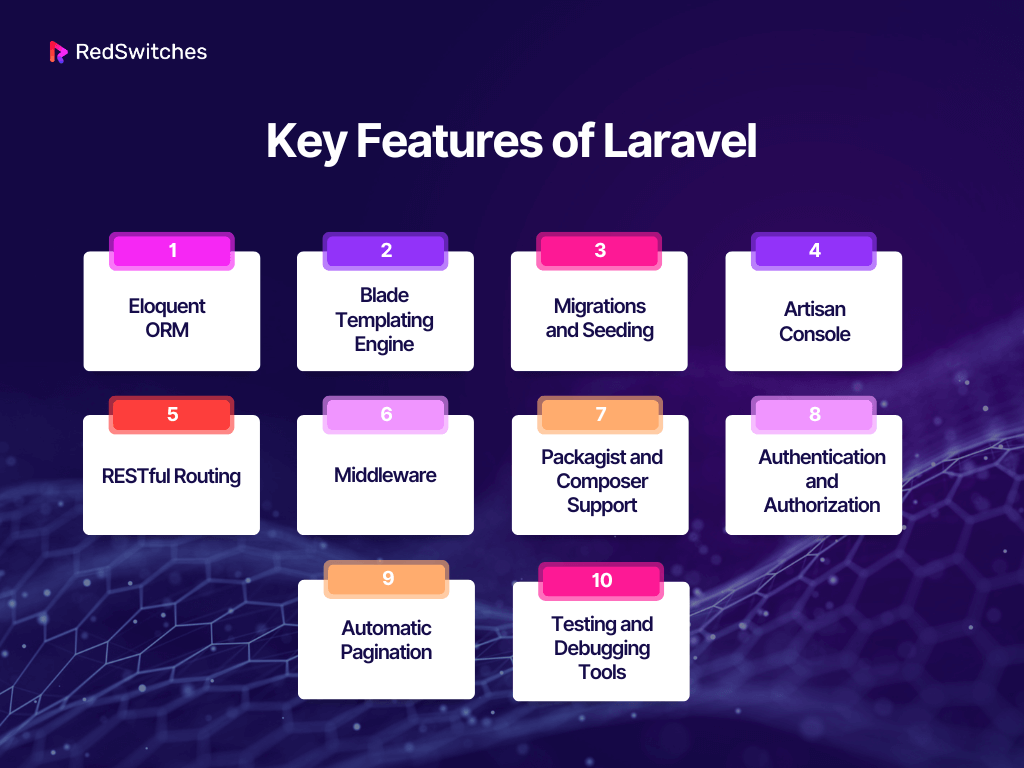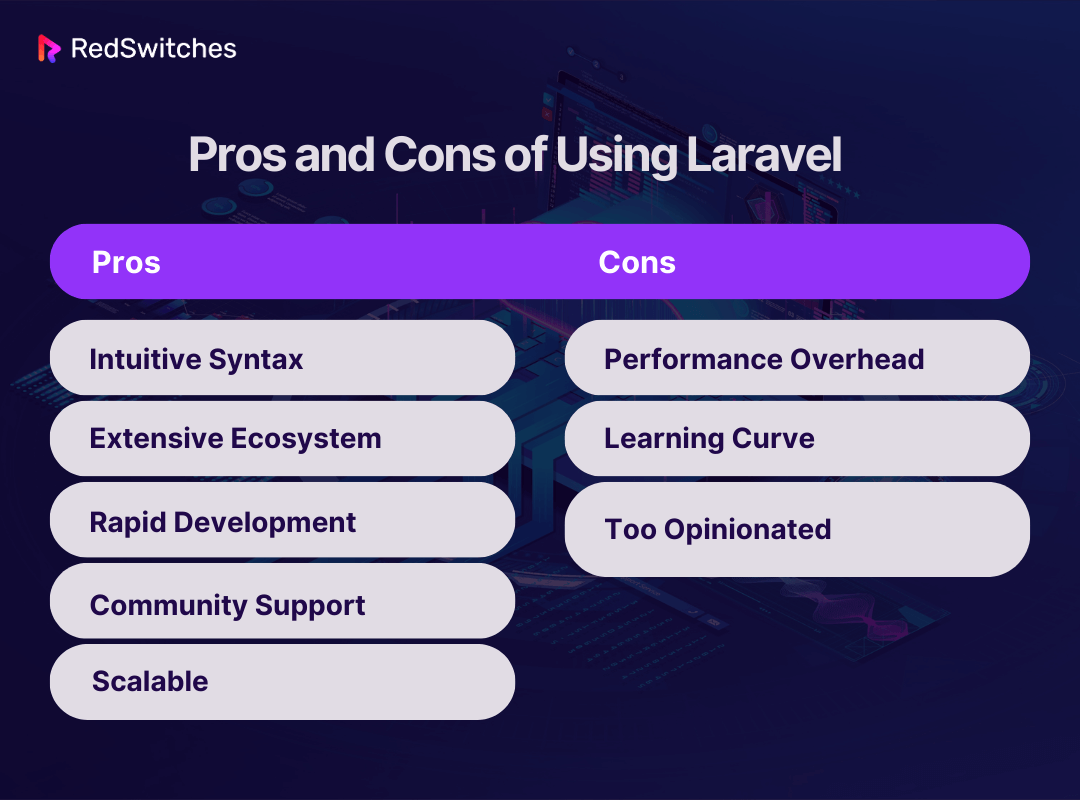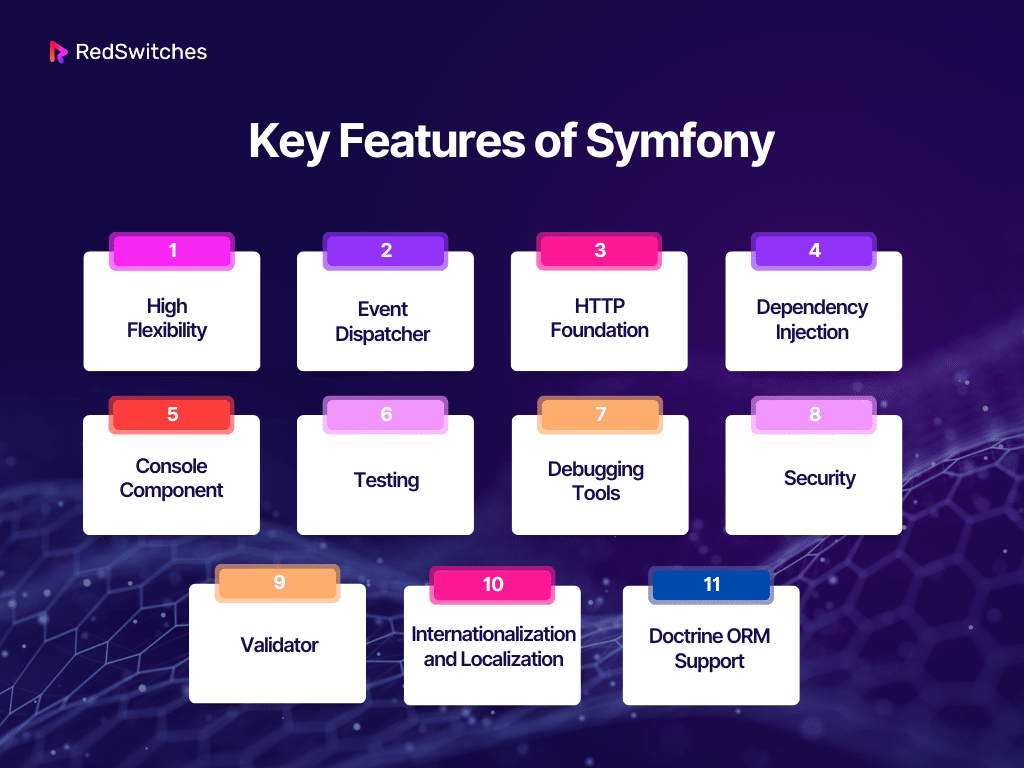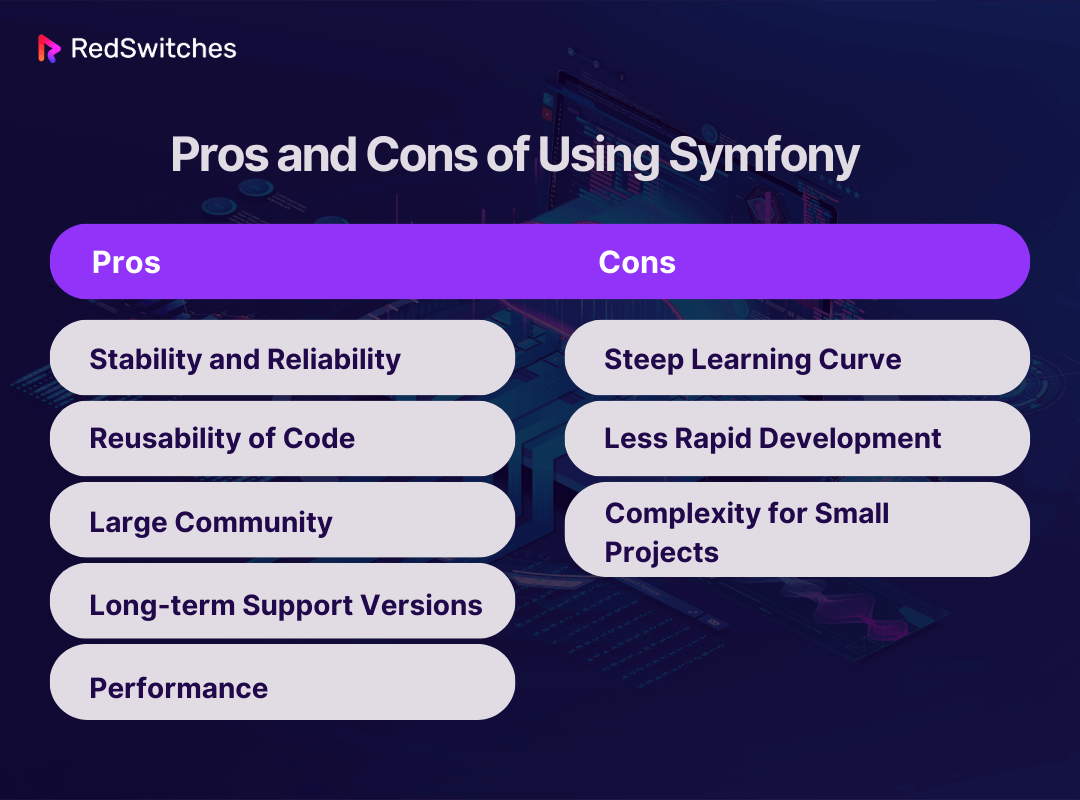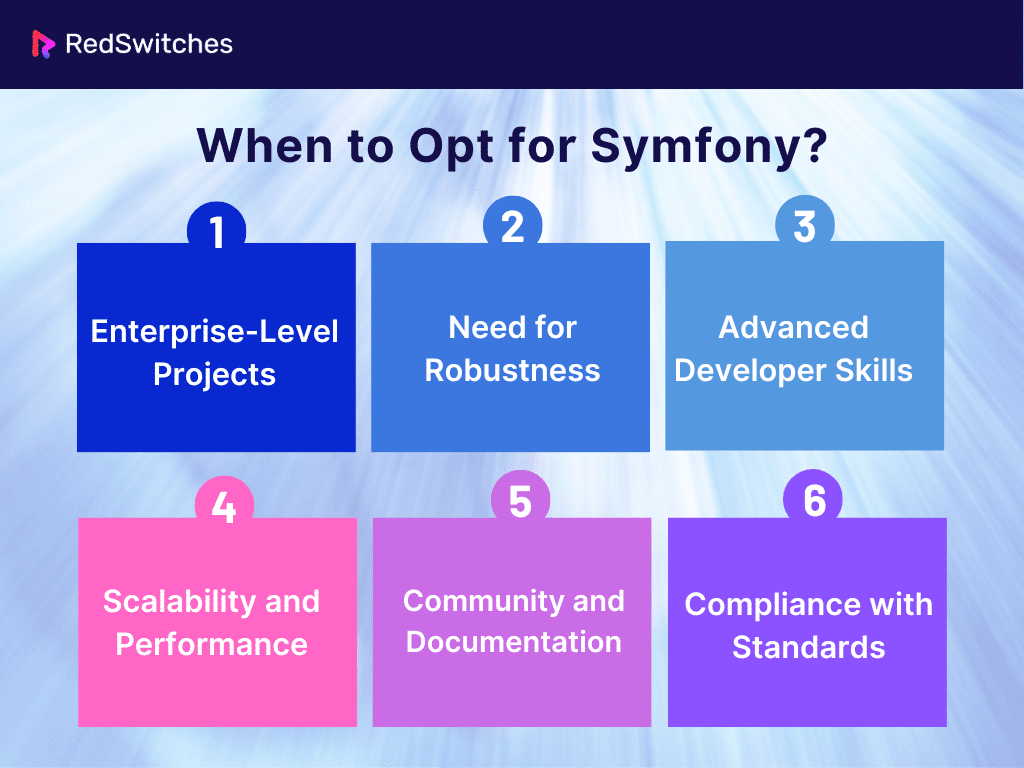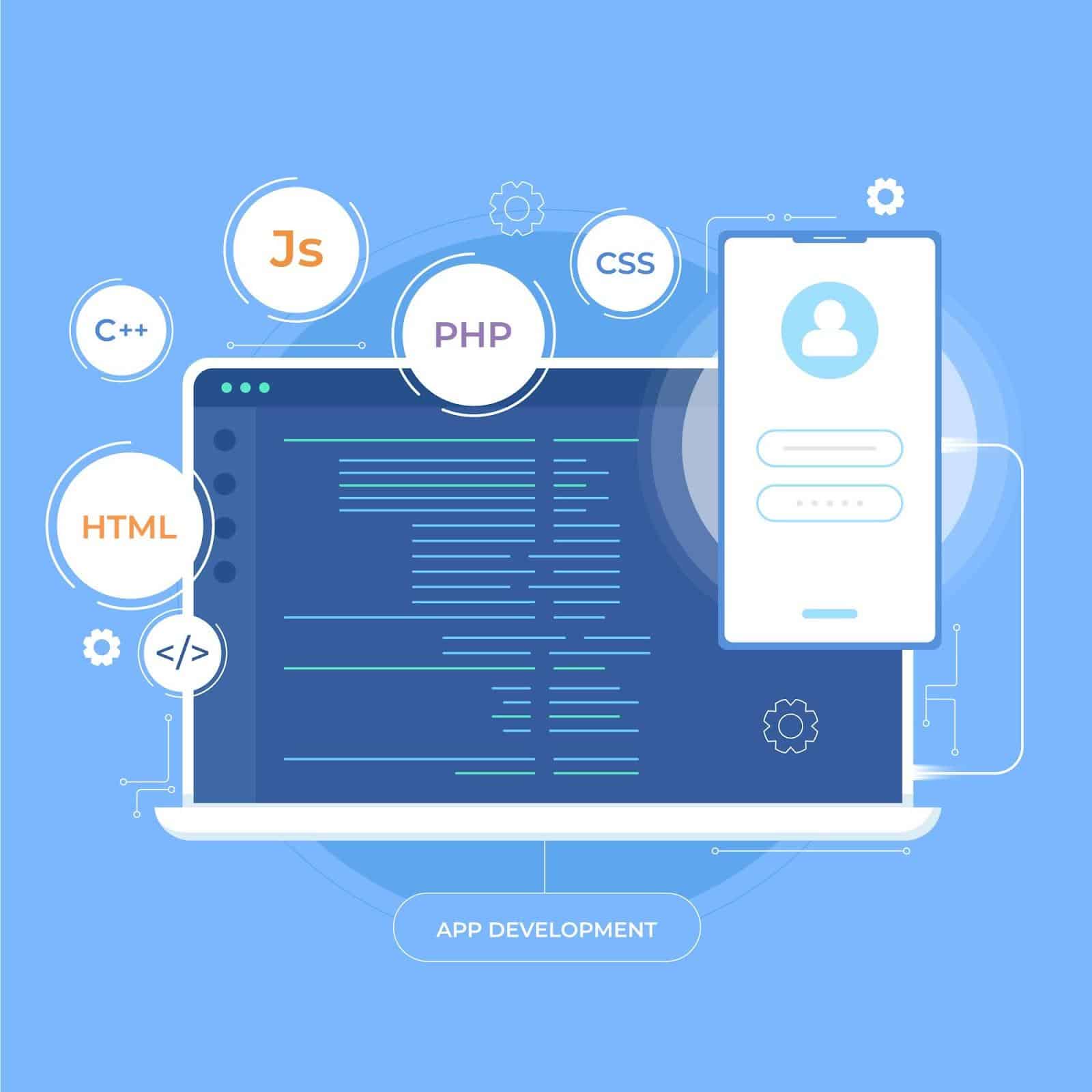In the ever-evolving web development landscape, the battle of PHP frameworks often centers on two leading contenders: Laravel and Symfony. Both frameworks boast extensive features that streamline the creation of robust web applications, but choosing one over the other can be a pivotal turning point in the success of a project.
As we delve into the “Laravel vs Symfony” debate, we uncover 13 key differences that distinguish these powerhouses. This article aims to dissect these differences, presenting a comprehensive comparison that aids developers and businesses alike in making an informed choice that aligns with their development philosophy, project requirements, and long-term vision. Whether you’re a seasoned developer, a startup co-founder, or a CTO making strategic decisions, understanding the intricacies of Laravel and Symfony is critical in harnessing the full potential of modern web application development.
Join us as we unravel the nuances that set these frameworks apart, offering clarity in a choice that may define the trajectory of your digital endeavors.
Table Of Contents
- What is Laravel?
- What Is Symfony?
- Symfony vs Laravel: Head-to-Head Comparison
- Basic Framework Configurations
- Routing and Controller
- Templates
- Dependency Injection
- Object Relational Mapping (ORM)
- Event Dispatcher vs. Middleware
- REST API
- Performance
- Learning Curve
- Security
- Choosing the Right Framework for Security
- Database Migration
- Support and Community
- Modularity and Scalability
- When to Opt for Laravel?
- When to Opt for Symfony?
- Key Takeaways
- FAQs
What is Laravel?
Credit: Laravel
Laravel is a free, open-source PHP web framework created by Taylor Otwell and first released in June 2011. It is designed to develop web applications following the model-view-controller (MVC) architectural pattern.
As a framework, it aims to alleviate the burden of routine tasks every day in most web projects, such as authentication, routing, sessions, and caching, thereby easing the development process. Laravel stands out with its elegant syntax, robust features, and strong community backing, making it one of the most popular PHP frameworks today.
Key Features of Laravel
Laravel is known for its expressive and refined syntax that prioritizes ease of use and maintainability. Some of the critical features that Laravel offers include
1. Eloquent ORM:
- Active Record Pattern: Offers a fluent and powerful approach to database interaction, enhancing developer experience.
- Database Interaction: Simplifies CRUD operations with an elegant, object-oriented approach.
2. Blade Templating Engine:
- Performance Optimization: Employs plain PHP code, ensuring efficient performance.
- Flexibility and Simplicity: Balances lightweight design with flexibility, streamlining template creation.
3. Migrations and Seeding:
- Database Version Control: Allows database schema definition via PHP, akin to version control systems.
- Structure Evolution: Facilitates smooth transitions and modifications of database structures over time.
4. Artisan Console:
- Automation of Repetitive Tasks: Reduces the need for boilerplate code through built-in command-line tools.
- Development Efficiency: Enhances productivity by automating common development tasks.
5. RESTful Routing:
- Intuitive API: Simplifies the definition of routes in web applications.
- RESTful Action Promotion: Encourages the use of RESTful principles in application routing.
6. Middleware:
- HTTP Request Filtering: Offers a key mechanism for controlling and filtering incoming HTTP requests.
- Authentication and Authorization: Plays a crucial role in implementing security features.
7. Packagist and Composer Support:
- Package Management: Facilitates easy library inclusion and dependency management.
- Robust Ecosystem Integration: Ensures seamless integration with the broader PHP ecosystem.
8. Authentication and Authorization:
- Simplified Implementation: Streamlines the process of setting up authentication and permissions.
- Security Enhancement: Bolsters application security with easy-to-implement yet robust systems.
9. Automatic Pagination:
- Simplified Pagination Process: Reduces the complexity and code required for implementing pagination.
- User Experience Improvement: Enhances the end-user experience in data-rich applications.
10. Testing and Debugging Tools:
- Integrated Unit Testing: Supports thorough testing practices to ensure application integrity.
- User-Friendly Error Handling: Aids in identifying and resolving issues effectively, enhancing application reliability.
Also Read: Laravel vs Angular: Decoding the Web Development Duel
Pros and Cons of Using Laravel
Pros:
- Intuitive Syntax: Laravel’s expressive syntax makes it accessible for beginners and comfortable for seasoned developers.
- Extensive Ecosystem: From starter kits like Laravel Spark to extensive pre-built applications, Laravel’s ecosystem is vibrant.
- Rapid Development: The framework is designed for rapid development, meaning you can go from concept to prototype to production faster.
- Community Support: A large and active community provides extensive resources, tutorials, and forums for troubleshooting.
- Scalable: Laravel applications can scale beautifully with the right server infrastructure and application architecture.
Cons:
- Performance Overhead: Laravel can be slower than lightweight frameworks or pure PHP coding under certain circumstances due to its many features.
- Learning Curve: While Laravel is praised for its ease of use, mastering its features can take time.
- Too Opinionated: Laravel’s opinions on how things should be done can sometimes limit developers’ use of a different approach.
Laravel Use Cases
Laravel is a versatile framework capable of handling a wide range of web applications, from small projects to large enterprise applications. Here are some everyday use cases:
- Content Management Systems (CMS): With Laravel’s robust features, developers can create custom CMS tailored to specific needs.
- E-commerce Platforms: The security and scalability provided by Laravel make it an excellent choice for developing e-commerce applications.
- Data-driven Applications: Laravel’s Eloquent ORM and migration system facilitate the development and management of database-centric apps.
- APIs for Mobile Applications: Laravel’s ability to serve as a backend and its support for RESTful routing make it perfect for building APIs.
- Software as a Service (SaaS): The framework’s natural ability to handle multiple database connections, queues, and extensive libraries makes it suitable for SaaS applications.
- Rapid Prototyping: The speed of development with Laravel enables startups to bring their ideas to life with a robust prototype quickly.
In the realm of PHP frameworks, Laravel shines as a beacon of modernity and efficiency. Whether you are building a simple blog or a comprehensive commercial package, Laravel equips you with a toolkit that is both broad in capabilities and deep in sophistication.
Also Read: Python vs PHP: How To Choose The Best Language For Your Projects?
What Is Symfony?
Credit: Symfony
Symfony is a powerful PHP framework designed to build robust web applications. It was initially released in October 2005 and was primarily sponsored by the French company SensioLabs. Symfony is built on reusable PHP components and follows the model-view-controller (MVC) paradigm.
It is known for its stability, adherence to PHP standards, and capacity to develop high-performance, complex web applications. As a framework, Symfony is geared towards enabling developers to set up a structured, maintainable, and upgradable framework that uses the best web development practices.
Key Features of Symfony
Symfony’s features offer a robust framework for developers, each contributing to its effectiveness and popularity:
1. High Flexibility:
- Bundle System: Simplifies packaging and distributing Symfony applications, allowing developers to selectively include components.
- Component Selection: Enables tailored application environments, enhancing control and customization.
2. Event Dispatcher:
- Event-Handling Mechanism: Facilitates the application of additional functionalities at runtime, enhancing dynamic behavior.
- Runtime Flexibility: Offers the ability to modify application behavior without altering the core structure.
3. HTTP Foundation:
- HTTP Specification Abstraction: Transforms HTTP standards into an object-oriented framework, promoting ease of use.
- Request and Response Flexibility: Improves handling of HTTP requests and responses, making them more adaptable.
4. Dependency Injection:
- Decoupling Logic: Separates object construction from business logic, leading to cleaner, more modular code.
- Code Modularity: Enhances code maintainability and scalability.
5. Console Component:
- Command-Line Command Creation: Aids in developing CLI commands integral to the Symfony framework.
- Framework Utilization: Enhances the efficiency of command-line operations within Symfony.
6. Testing:
- Unit and Functional Tests: Emphasizes testing at multiple levels for robust application development.
- Test-Driven Development Tools: Supports a development approach focused on pre-defined tests.
7. Debugging Tools:
- Symfony Debug and Web Profiler: Offer detailed debugging information and performance metrics.
- Performance Insights: Provides essential data for optimizing applications.
8. Security:
- Authentication and Authorization: Manages user access control effectively.
- Comprehensive Security Component: Ensures a secure environment for applications.
9. Validator:
- Data Validation: Enforces data integrity by adhering to specific rules.
- Safety and Simplicity: Enhances data handling security and simplifies validation processes.
10. Internationalization and Localization:
- Multilingual Application Tools: Facilitates the creation of applications in multiple languages.
- Global Audience Reach: Enhances the application’s accessibility to a broader audience.
11. Doctrine ORM Support:
- Database Interaction: Commonly used with Symfony for efficient database management.
- Object-Database Mapping: Simplifies the process of mapping objects to database rows, enhancing data handling.
Pros and Cons of Using Symfony
Pros:
- Stability and Reliability: With its long history, Symfony is known for its stability and well-documented best practices.
- Reusability of Code: The bundle system and component-based architecture allow for high levels of code reusability.
- Large Community: Symfony has a large, active community and many third-party bundles to add functionality quickly.
- Long-term Support Versions: Some versions of Symfony come with long-term support (LTS), which is essential for enterprise applications.
- Performance: When optimized, Symfony can handle large-scale applications and high levels of traffic efficiently.
Cons:
- Steep Learning Curve: The framework can be overwhelming due to its many components and the level of detail in its documentation.
- Less Rapid Development: Compared to Laravel, Symfony’s setup and development process can take longer.
- Complexity for Small Projects: For very simple applications, the robustness of Symfony can be more of a hindrance than a benefit.
Symfony Use Cases
Symfony is particularly well-suited for complex and high-demanding web applications. Some everyday use cases include:
- Enterprise Applications: Symfony’s stability and comprehensive features make it ideal for enterprise applications with complex business logic.
- RESTful APIs: Its structured approach is perfect for building scalable, high-performance APIs.
- High-Traffic Websites: Symfony can efficiently handle high loads, making it suitable for websites with high traffic.
- Modular Applications: Due to its bundle system, Symfony is an excellent choice for building applications that require a high degree of modularity.
- Complex Backend Systems: Its robustness and flexibility make it ideal for complex backends for web or mobile applications.
Symfony has carved out a reputation as the framework of choice for complex enterprise-level projects. With an emphasis on comprehensive documentation, consistency, and a “do it right” philosophy, Symfony appeals to those who wish to build applications with long-term vision and stability in mind.
Want to understand what really makes up a website? Dive into our article exploring the four fundamental components of a website.
Symfony vs Laravel: Head-to-Head Comparison
Now that we understand the basics of Laravel and Symfony, let’s dive deeper into what sets them apart. Here are some key differences between Laravel and Symfony you must know.
Basic Framework Configurations
When embarking on the web development journey, the choice between Laravel and Symfony can have significant implications on the trajectory of your project. Both frameworks stand tall in the PHP community, but their approach to basic configurations offers a glimpse into their underlying philosophies.
Configuration File Format and Location
Both Laravel and Symfony utilize a directory conventionally named config/ for housing configuration files. However, they diverge in their file format preferences:
- Symfony: It predominantly uses YAML or XML files for configuration. Developers may choose the format they’re most comfortable with, thus allowing flexibility and precision in defining settings.
- Laravel: All configurations are neatly arranged in PHP files within the config/ directory. This straightforward approach caters to PHP developers accustomed to the language’s syntax.
Configuration Options and Flexibility
The depth and flexibility of configuration are where Laravel and Symfony truly part ways:
- Symfony:
- Offers a broad spectrum of configuration options, including but not limited to database connections, caching, and routing.
- Highly flexible, allowing developers to override default configurations and introduce custom settings to suit complex needs.
- Laravel:
- While the range of options might seem smaller relative to Symfony, Laravel covers the essentials and most common requirements effectively.
- Offers less flexibility than Symfony, but it maintains a balance between customization and simplicity.
Ease of Use
The ease of configuring each framework often influences a developer’s choice:
- Symfony can be seen as more complex due to its granular level of control, which might appeal to developers who appreciate a meticulous setup.
- Laravel is often regarded as more accessible, particularly for those looking to hit the ground running without the steep learning curve.
Deciding whether to go with Laravel or Symfony hinges on the specific demands of your project and your expertise in PHP development.
Choose Symfony if:
- You require extensive flexibility and customization capabilities.
- Your project is complex, with expectations for long-term evolution and scaling.
- You have a strong background in PHP and are comfortable with object-oriented programming.
Choose Laravel if:
- You’re relatively new to PHP or prefer a more opinionated structure.
- Your application falls into the simple-to-medium complexity range.
- You value ease of use and rapid development over granular control.
Despite these guidelines, there is no substitute for hands-on experience. The most effective method to ascertain whether Laravel vs Symfony aligns with your development style and project needs is to experiment with both. By setting up a basic configuration in each framework, you can gauge which resonates more with your workflow and your application’s demands.
Routing and Controller
Navigating through the complexities of web development requires a solid understanding of routing and controllers—a fundamental aspect where Laravel and Symfony differ significantly. These differences can influence the overall Symfony vs Laravel performance and developer experience.
Symfony: Flexible and Feature-Rich Routing
- Route Definition: Symfony stands out with its highly flexible routing, allowing routes to be defined in YAML, XML, or PHP, offering versatility for developers.
- Routing Features:
- Route Parameters: Essential for dynamic routing based on URL segments.
- Route Groups: Facilitate the organization of routes that share common attributes.
- Route Middleware: Handy for applying filters and conditions to HTTP requests.
- Controller Organization: Controllers in Symfony are packaged into bundles, promoting reusability and modularity across applications.
- Inheritance and DI: Symfony supports controller inheritance, promotes DRY principles, and embraces dependency injection, enhancing maintainability and scalability.
Laravel: Simplicity Meets Power
- Routing System: Laravel provides a simpler yet comprehensive routing system. All routes are defined in PHP files and streamlined for quick setup and easy understanding.
- Routing Features:
- Route Parameters: Allow for dynamic responses based on user input.
- Route Middleware: Enable HTTP request filtering before reaching the application core.
- Named Routes: Simplify the referencing of routes throughout the application.
- Controller Placement: Following a convention-over-configuration philosophy, Laravel controllers are placed within the app/Http/Controllers directory.
- Controller Flexibility: Laravel encourages controller inheritance and utilizes a powerful dependency injection system to resolve class dependencies automatically.
Comparison of Routing and Controller Systems
When evaluating Laravel vs Symfony, it’s essential to consider how each framework’s routing and controller capabilities align with your project needs:
- Symfony:
- Route definition can be in YAML, XML, or PHP.
- Offers a rich set of routing features, including parameters, groups, and middleware.
- Organizes controllers into bundles for greater modularity.
- Supports inheritance and dependency injection for controllers.
- Laravel:
- Route definition is exclusively PHP-based.
- Provides essential routing features such as parameters, middleware, and named routes.
- Controllers are stored in a specific directory for easy access.
- Also supports inheritance and dependency injection for controllers.
Selecting the Appropriate Framework
The project’s specific demands should dictate your choice between Symfony and Laravel:
Opt for Symfony if:
- You require a highly customizable routing system to accommodate complex application behaviors.
- You need a robust controller system with the benefits of inheritance and dependency injection.
- Your project is a large-scale, sophisticated web application necessitating detailed configuration and long-term development planning.
Choose Laravel if:
- You prefer a straightforward, easy-to-learn, and implemented routing system.
- You’re in search of a controller system that is both powerful and streamlined for rapid application development.
- You’re newer to PHP or web development, or your project is more modest in size and complexity.
Ultimately, to make a well-informed decision on Laravel vs Symfony, the ideal approach is to experiment with both frameworks. Each has its strengths and ideal use cases, and direct experience will illuminate which framework’s routing and controller philosophy best suits your work style and project requirements.
Also Read: Understanding the different Types of Web Hosting Services: A Comprehensive Guide
Templates
Templates bridge your application’s data and how that data is presented to the user in a web context. Both Laravel vs Symfony have their template engines, each with a distinctive approach to rendering views.
Symfony: The Twig Template Engine
Symfony defaults to the Twig template engine, known for its flexibility and performance:
- Template Syntax: Twig uses a syntax that focuses on speed and security, allowing developers to create powerful templates that are also fast to render.
- Features:
- Inheritance: Enables the extension of one base template across different views, promoting DRY principles.
- Functions and Filters: Various built-in functionalities for manipulating and displaying data are offered.
- Compatibility: Twig isn’t exclusive to Symfony; it’s a favored choice among other PHP frameworks and content management systems like Drupal and Joomla, providing a common ground for developers.
Laravel: The Blade Template Engine
Laravel utilizes Blade, a template engine that is inherently simple yet surprisingly powerful:
- Template Syntax: Blade’s syntax is designed to be intuitive and expressive, making it straightforward for developers to jump in and start crafting views.
- Features:
- Templating Directives: Blade provides directives for common PHP control structures, which can be mixed with plain PHP code in views.
- Template Inheritance: Blade also supports views’ inheritance, enabling developers to define a master layout that individual views can extend.
- Variable Interpolation: Blade templates are compiled into plain PHP and cached until they are modified, meaning there is no overhead to using Blade.
Comparing Template Engines
When examining Laravel vs Symfony in the context of template engines, consider the following contrasts:
- Twig (Symfony):
- Fast and flexible syntax.
- Supports a wide range of features like inheritance and filters.
- Broadly compatible with other PHP frameworks.
- Blade (Laravel):
- Simple, expressive syntax tailored for Laravel.
- Includes features like templating directives and easy variable interpolation.
- Designed explicitly for Laravel, ensuring seamless integration with the framework’s other features.
Choosing the Right Template Engine
Your choice between Twig and Blade should be guided by your project’s needs and your personal or team’s preference for template syntax and features.
Choose Twig if:
- You require a template engine with a comprehensive feature set that supports complex view creation.
- You are looking for compatibility with other PHP frameworks and systems, which can be especially important in projects across different platforms.
- You or your team already have experience with Twig, which would allow for a smoother transition in adopting Symfony.
Choose Blade if:
- You prefer a template engine that prioritizes simplicity without compromising on advanced features like template inheritance.
- Your project is focused on Laravel, and you want to harness Blade’s capabilities tailored specifically to the framework.
- You want to rapidly develop views with minimal overhead, leveraging Blade’s efficient compilation and caching mechanism.
To determine which template engine best fits you, it’s recommended to experiment with Twig and Blade. This hands-on experience can give you a practical understanding of how each engine can serve the specific requirements of your web application. The Symfony vs Laravel performance in templating can also be influenced by your project’s complexity, team size, and future scaling needs.
Credit: Unsplash
Dependency Injection
Dependency Injection (DI) is a crucial aspect of modern software development, promoting loose coupling and testability of code. Both Laravel and Symfony implement DI, but their approaches reveal differences that may sway a developer’s preference in the Laravel vs Symfony debate.
Symfony: A Flexible DI System
Symfony’s DI container is a powerhouse of flexibility and features:
- Dependency Definition: In Symfony, you can define dependencies either through configuration files (YAML, XML) or directly in PHP code, providing options for developers who prefer different levels of abstraction or directness.
- Injection Methods: It supports constructor and setter injection, allowing developers to choose the best method for their design patterns.
- Advanced DI Features:
- Lazy Loading: Services in Symfony can be instantiated only when needed, improving performance.
- Autowiring: Automatically determines and injects dependencies, saving time on configuration.
- Service Decoration: Enables the extension or modification of services without changing the original service class.
Laravel: Simplicity and Power in DI
Laravel’s DI system is designed to be both simple and powerful, providing an approachable yet robust toolset:
- Dependency Definition: Dependencies in Laravel are defined in PHP, emphasizing convention over configuration to streamline the development process.
- Injection Methods: Laravel also employs constructor and setter injection, integrating smoothly with its intuitive service container.
- DI Features:
- Dependency Resolution: Laravel’s service container automatically handles dependency resolution for a smooth experience.
- Singletons: The container can bind a class or interface to a single instance, only resolving it once.
- Facades: Provide a static-like interface to classes available in the application’s service container, simplifying access to these services.
Making a Choice For DI
Determining whether to choose Laravel or Symfony for dependency injection can hinge on the complexity of your needs and your comfort with configuration.
Select Symfony if:
- You demand high flexibility and fine-grained control over DI configuration.
- You want to leverage advanced features like lazy loading, auto wiring, and service decoration.
- Your project is a complex, large-scale application with long-term development considerations.
Opt for Laravel if:
- You prefer a DI system that is straightforward and accessible without sacrificing power.
- Your needs are well-served by a robust set of basic DI features.
- You are newer to PHP or web development or working on a more straightforward or mid-sized application.
Ultimately, engaging with both is the best way to decide which framework’s DI system is the most suitable for your project. Testing out the DI capabilities in Laravel vs Symfony can offer a deeper insight into how each can cater to the specific requirements of your application.
If you’re new to web development, understanding web hosting is crucial. Check out our comprehensive guide on how web hosting works to get started.
Object Relational Mapping (ORM)
The choice of an Object Relational Mapping (ORM) system can profoundly influence how you interact with a database in any PHP application. Let’s compare the ORMs of Laravel vs Symfony to understand their core differences.
Doctrine: Symfony’s ORM
- Features:
- High flexibility with advanced mapping capabilities.
- Support for complex queries and database operations.
- Compatibility:
- Doctrine is not limited to Symfony and is used across other PHP frameworks.
- Learning Curve:
- Generally steeper but offers powerful features for those who master it.
Eloquent: Laravel’s ORM
- Features:
- User-friendly with an active record implementation.
- Elegant syntax that integrates fluently with Laravel.
- Compatibility:
- Eloquent is crafted exclusively for Laravel applications.
- Learning Curve:
- Easier for beginners and highly readable for seasoned developers.
Deciding on an ORM
Your choice between Doctrine and Eloquent should be influenced by your project’s needs and familiarity with ORMs.
When to Choose Doctrine:
- You require advanced ORM features and customizations.
- Your project is complex, with potentially intricate database interactions.
- You are comfortable with, or willing to learn, its comprehensive feature set.
When to Choose Eloquent:
- You prefer simplicity and rapid development.
- You need an ORM that is straightforward and well-documented within the Laravel ecosystem.
- Your application is of moderate complexity or you’re newer to PHP frameworks.
Additional Considerations
- Performance: Doctrine is often cited for better performance in complex scenarios, while Eloquent is praised for its efficiency in typical CRUD operations.
- Community Support: Both ORMs are well-supported with large communities, extensive documentation, and active development.
- Learning Curve: Eloquent is generally easier to pick up, making it a favorite for quick projects and developers new to PHP. Doctrine’s advanced capabilities reward those who invest time in learning it.
To make an informed decision, it’s best to explore Doctrine and Eloquent in practice, considering how each aligns with your project’s scale and development workflow.
Event Dispatcher vs. Middleware
Event dispatchers and middleware are crucial components for modern web applications, handling communication between different parts of the application and managing the HTTP request-response lifecycle, respectively.
Event Dispatcher
The event dispatcher pattern is implemented in Laravel and Symfony to facilitate application-wide event handling.
- Symfony:
- Offers a powerful and flexible event dispatcher central to the framework’s architecture.
- Allows for various listener configurations suitable for various applications.
- Laravel:
- Also features a robust event dispatcher, enabling clear communication across the application.
- Event handling in Laravel is designed to be straightforward, making it accessible even for developers new to event-driven programming.
Middleware
Middleware acts as a filter and processor for HTTP requests and responses and is present in both Laravel and Symfony with differing implementations.
- Symfony:
- Symfony’s middleware, often called event listeners or kernel events, is part of a more extensive, flexible system that can be prioritized and tagged for specific conditions.
- Laravel:
- Implements middleware as a series of layered functions, which allows for an intuitive stacking and ordering system.
- This stack-based approach simplifies the addition and removal of middleware without altering the core application code.
Choosing the Right Framework for Event Dispatchers and Middleware
The decision between Laravel vs Symfony for event management and middleware should align with your project’s architectural needs and your personal or team’s preferences.
When to Choose Symfony:
- You require a comprehensive event dispatcher for complex event handling across the application.
- You’re looking for a highly customizable middleware system with the flexibility to adapt to various scenarios.
- Your project is complex or requires a scalable, long-term solution with the potential for high customization.
When to Choose Laravel:
- You prefer a more straightforward approach to middleware with an easy-to-understand stacking system.
- Basic event dispatcher features fulfill your application’s needs.
- You’re newer to PHP or web development and require a solution that’s easier to grasp and work with.
Experimenting with both frameworks’ event dispatcher and middleware systems will give you the best perspective on which aligns with your workflow and project requirements. Whether it’s the flexibility of Symfony or the simplicity of Laravel, the right choice will ultimately depend on the specific needs of your web application.
Credit: Freepik
REST API
In the quest to build efficient and scalable REST APIs with PHP, Laravel vs Symfony emerge as two of the foremost contenders. Each framework brings unique tools and philosophies; choosing between them requires project needs and developer expertise.
Symfony for REST APIs
Symfony, with its comprehensive framework capabilities, offers extensive features that are beneficial for REST API development:
- Routing & Dependency Injection: These core components are well-integrated and provide the backbone for robust API development.
- ORM: Doctrine is the default ORM for Symfony, known for its rich data mapping capabilities.
- REST API Components: Tools like FOSRestBundle and JMSSerializerBundle are tailored for REST API development, adding layers of flexibility and customization.
- Learning Curve: Typically steeper due to its vast ecosystem, Symfony is ideal for those with a solid background in PHP and desire a wide range of features.
Laravel for REST APIs
Laravel is often regarded as a more accessible framework without compromising on the power needed to build high-quality REST APIs:
- Routing & Dependency Injection: Laravel provides a straightforward way to handle these elements, suitable for rapid API development.
- ORM: Eloquent ORM is Laravel’s active record implementation, praised for its simplicity and readability.
- REST API Packages: Packages like Laravel Passport for authentication and Laravel Dingo API provide extended functionality for API services.
- Learning Curve: It is easier to grasp for beginners or those new to web development, making it an appealing choice for quick project ramp-up.
Choosing the Right Framework for Your REST API
Whether to use Laravel vs Symfony for your REST API should be informed by specific project requirements and personal or team familiarity with the frameworks.
Choose Symfony if:
- You need a broad set of integrated features for complex API development.
- Your project demands deep customization and extensive functionality.
- You have experience with PHP frameworks and value a large, active community for support.
Choose Laravel if:
- You are stepping into PHP or web development with a preference for a gentle learning curve.
- You aim to create a simple to medium-sized REST API with efficiency and speed.
- You wish to utilize specific packages like Laravel Passport or Laravel Dingo API for your REST API.
Both frameworks boast large and active communities, offering extensive resources for troubleshooting and support. Given the exemplary architecture and optimization, performance and scalability are achievable with either option. To truly determine which framework is the optimal fit, it’s advisable to prototype REST APIs with Laravel vs Symfony, gauging which aligns best with your workflow and project vision.
Performance
Regarding the performance of PHP frameworks, both Laravel vs Symfony are designed to deliver speed and efficiency, with Symfony often being cited as the slightly more performant contender.
Performance Optimization in Symfony
Symfony is built with several features contributing to its performance:
- Caching: Symfony excels with its advanced caching mechanisms, which help reduce load times by storing frequently accessed data in memory.
- Bundles: The bundle system in Symfony allows for modular development, meaning each bundle can be optimized, contributing to the overall performance.
- Dependency Injection: Using dependency injection, Symfony minimizes resource consumption, reducing the need to instantiate objects repeatedly.
Performance Enhancement in Laravel
Laravel, while also performant, approaches optimization differently:
- Eloquent ORM: Known for its lightweight operations, it helps make database interactions efficient and fast.
- Blade Templating Engine: Blade compiles templates directly into PHP, avoiding the overhead of rendering views on each request.
- Service Containers: Like Symfony, Laravel’s service containers efficiently manage class dependencies and injections, streamlining object creation.
While Symfony is often regarded as the more performant framework between the two, it’s important to note that the actual performance difference is relatively minor. For most applications, the decision between Laravel vs Symfony should be based on other factors, such as the project requirements, developer expertise, and the framework’s compatibility with the project’s long-term goals, rather than performance alone. Each framework’s extensive optimization features mean that with the proper development practices, both can power fast, responsive applications.
Learning Curve
The learning curve associated with a PHP framework is essential, particularly regarding Laravel vs Symfony. These frameworks differ significantly in complexity and breadth of features, influencing how quickly a developer can become proficient in using them.
Symfony’s Learning Curve
Symfony’s comprehensive nature means there’s more to learn upfront:
- Complexity: It’s a feature-rich framework that requires an understanding of its components and their interactions.
- Features: While powerful, the wide range of features can be overwhelming for newcomers.
- Community and Documentation: Symfony’s large community and extensive documentation provide substantial learning support.
Laravel’s Learning Curve
Laravel is often touted as the more accessible framework, especially for those new to PHP:
- Simplicity: It offers a straightforward and elegant toolkit, allowing a smoother entry into web development.
- Features: While not as exhaustive as Symfony’s, Laravel’s features are comprehensive enough to build robust applications, with additional packages available to extend functionality.
- Educational Resources: Laravel benefits from abundant tutorials, video courses, and a welcoming community that can aid in the learning process.
Choosing the Right Framework
Your choice between Symfony and Laravel should be guided by your experience level, project needs, and the time you can devote to learning:
- Opt for Laravel if:
- You are new to PHP or prefer a framework that’s easier to learn.
- Your project requirements can be met with Laravel’s core features, supplemented by its extensive package ecosystem.
- Choose Symfony if:
- You have some experience in PHP and are not daunted by a steeper learning curve.
- You need a framework with extensive built-in functionalities for a complex and scalable project.
While both frameworks have their learning curves, the right choice ultimately depends on your particular situation. Laravel is ideal for those seeking a quick start, while Symfony is suited for developers looking for depth and breadth in a framework’s capabilities. Experimenting with Laravel vs Symfony will give you the best sense of which one aligns with your learning style and project requirements.
Credit: Freepik
Security
Security is a paramount concern in web application development, and both Laravel and Symfony equip developers with robust features to safeguard applications. Each framework, however, has its unique approach to security.
Security Features in Symfony
Symfony’s security component is extensive and includes:
- Session Management: Offers comprehensive session management to prevent session hijacking.
- CSRF Protection: Built-in CSRF protection guards against cross-site request forgery.
- Input Validation: Various input validation options help prevent code injection attacks.
- Firewalls: Symfony uses firewalls for securing requests and controlling access based on patterns.
- ACLs: Access Control Lists in Symfony provide granular permissions over the resources.
Security Features in Laravel
Laravel’s security features, while also comprehensive, are packaged differently:
- Authentication: Laravel provides various authentication methods, including OAuth2 and Laravel Passport, for securing user access.
- Authorization: Features like Laravel Gates and Policies help implement complex authorization logic.
- CSRF Protection: CSRF protection is inherently included to secure applications from forgery.
- Input Validation: Laravel has robust input validation rules to ensure the integrity of user input.
- Security Middleware: Middleware like Laravel Sanctum and Helmet can be employed to add additional layers of security.
Choosing the Right Framework for Security
Selecting the appropriate framework for security should be based on your application’s needs and the complexity of security requirements:
- Choose Symfony if:
- Your application requires a broad set of security features, such as firewalls and ACLs.
- You are developing a complex application where fine-tuned security configurations are necessary.
- You grasp PHP well and are comfortable implementing object-oriented security measures.
- Choose Laravel if:
- You are newer to PHP or prefer a framework perceived as easier to learn.
- Straightforward and robust authorization and authentication features serve your application’s security needs.
- You value a framework that integrates security features seamlessly and simply.
Both Laravel vs Symfony provide the tools necessary to build secure applications. Still, Symfony’s security component is often seen as more complex and flexible, whereas Laravel’s security features are integrated in a more user-friendly manner.
Protecting your online presence is more important than ever. Discover the primary features and benefits of Web Security Gateways and how they can safeguard your digital landscape.
Database Migration
Database migrations are essential for managing the evolution of your project’s data schema. Laravel and Symfony approach migrations differently, offering tools that cater to varying levels of complexity.
Symfony’s Doctrine Migrations
Symfony’s database migration system is built on the robustness of Doctrine Migrations:
- Version Control: Keeps track of each migration version, offering a clear migration history and rollback options.
- Database Independence: Doctrine Migrations are built to work across different DBMS, providing flexibility if you need to switch databases.
- Transactions: It utilizes database transactions to ensure the safety and atomicity of each migration operation.
Laravel’s Migration System
Laravel’s migration system is known for its simplicity and ease of use:
- Scaffolding: Offers command-line generators to create migrations quickly, streamlining the development process.
- Seeding: Alongside migrations, Laravel provides a seeding system for populating databases with initial data sets.
- Rollback: With a simple command, Laravel migrations can be rolled back, making it easy to undo changes.
Comparison of Migration Systems
While both frameworks provide capable systems for database migration, some nuances distinguish them:
- Doctrine Migrations (Symfony):
- Offers detailed version control for each migration.
- Supports a wide variety of database systems.
- Ensures migration integrity with transactions.
- Laravel Migrations:
- Focuses on speed and simplicity with scaffolding tools.
- Facilitates easy seeding of database data.
- Allows for straightforward rollback of migrations.
Choosing the Right Framework for Database Migrations
Your choice between Symfony and Laravel for database migrations should be guided by the needs of your project and your own experience:
- Choose Symfony if:
- Your project demands a migration system that offers version control and flexibility across different databases.
- You are working on a complex or long-term project that might benefit from the advanced features of Doctrine Migrations.
- You have a solid background in PHP and are comfortable with object-oriented concepts.
- Choose Laravel if:
- You are starting with PHP or web development and prefer a more accessible migration system.
- Your web application is of a smaller or medium scale where ease of use is prioritized.
- You value a migration system that can rapidly get you up and running with minimal fuss.
In conclusion, both Laravel vs Symfony have their strengths regarding database migration systems. Symfony’s Doctrine Migrations offers a more feature-rich environment suitable for developers who need greater control and flexibility.
Laravel’s migration system is more streamlined, offering a user-friendly approach ideal for developers who want to quickly implement migrations and focus on other aspects of their application. Experimentation with both frameworks will give you a clearer insight into which is better suited for your project’s requirements.
Credit: Freepik
Support and Community
When embarking on any software development project, the ecosystem’s support and community can significantly impact your progress and success. Vibrant communities and extensive resources bolster both Laravel vs Symfony, but subtle differences are worth noting.
Symfony’s Community and Support
Symfony’s community is rooted deeply in professional and enterprise-level circles:
- Community Size: Large with a strong presence of experienced developers, often within enterprise environments.
- Support: Known for its supportive network, Symfony’s community provides a solid foundation for problem-solving and learning.
- Resources: Offers an abundance of official and third-party documentation, tutorials, and forums.
Laravel’s Community and Support
Laravel has quickly become a favorite among developers for its ease of use and robust features:
- Community Size: Equally large and particularly active among startups and small to medium businesses.
- Support: The Laravel community is renowned for being exceptionally welcoming and helpful to new and seasoned developers.
- Resources: Boasts comprehensive documentation, widespread tutorials, active discussion forums, and social media presence.
Choosing the Right Framework Based on Support and Community
Your choice between Laravel and Symfony may come down to personal preference and the nature of your project:
- Choose Symfony if:
- You are working on enterprise-level applications and value a community with deep experience in complex systems.
- You prefer a framework known for a methodical and extensive approach to problem-solving and documentation.
- Choose Laravel if:
- You are new to web development or prefer a framework known for its ease of entry and friendly support.
- You are looking to quickly prototype and develop projects with a community that values modern web development practices.
Symfony and Laravel offer a wealth of knowledge, making neither a poor choice regarding community and support. The deciding factor often lies in which community’s approach resonates more with your development style and project needs.
To truly understand which framework you prefer, engaging with both communities through forums and social media and trying out both frameworks can provide valuable insight into which one suits you best.
Modularity and Scalability
In the landscape of PHP frameworks, modularity, and scalability are vital attributes that make Symfony and Laravel attractive choices for building modern applications. Here’s a comparative look at both Laravel vs Symfony in this regard.
Modularity in Symfony
Symfony stands out with its highly modular structure:
- Bundles: Symfony comprises numerous independent bundles, each adding functionalities like security, templating, and more.
- Customization: Creating your bundles to encapsulate specific functionalities or features is a common practice, enhancing modularity.
- Scalability: The framework’s architecture lends itself to easy scaling, where you can add more bundles or servers to accommodate growing applications.
Modularity in Laravel
Laravel’s modularity, while not as pronounced as Symfony’s, still offers much flexibility:
- Core Features: It includes several out-of-the-box web development features that can be extended or replaced.
- Packages: Additional features can be integrated through Laravel’s package system, which, similar to Symfony’s bundles, allows for expansion.
Scalability of Both Frameworks
Both frameworks are designed with scalability in mind. Still, they approach it differently:
- Symfony: Thanks to its bundle system, Symfony can be scaled by integrating more bundles, making it highly adaptable for complex projects.
- Laravel: Scalability is achieved by adding more servers or utilizing Laravel’s queue system for load distribution and task management.
Choosing the Right Framework
Your choice between Symfony and Laravel will largely depend on the scale of your project and your familiarity with PHP:
- Opt for Symfony if:
- You need exceptional modularity for a highly scalable, intricate application.
- Your project requires long-term scalability, and you’re well-versed in PHP and object-oriented programming.
- Choose Laravel if:
- You’re starting with PHP or web development and prefer a more straightforward framework.
- You require a scalable solution but also value ease of use and a strong user community.
Both frameworks can support large-scale applications, so the decision should be based on the specific needs of your project and your comfort with the framework’s modularity system. Whether you choose Symfony’s extensive modularity and scalability or the ease of use and strong community support of Laravel, both frameworks offer the necessary tools to build and scale your application effectively.
Here is the summary of the Laravel vs Symfony comparison.
When to Opt for Laravel?
Laravel is a prime choice for specific web development scenarios, offering a blend of efficiency, simplicity, and robust community support. Here’s when you might choose Laravel:
Quick Development Cycle
- Rapid Prototyping: Ideal for swiftly transforming ideas into working models.
- Artisan Console: Speeds up repetitive tasks, aiding in a faster development cycle.
Beginner-Friendly
- Comprehensive Documentation: Clear and thorough guides for easy onboarding.
- Ease of Learning: Intuitive for newcomers, with a gentle learning curve.
Focus on UI/UX
- Blade Templating: Provides a simple yet powerful system for crafting user interfaces.
- Laravel Mix: Facilitates front-end asset management, optimizing the workflow for UI development.
Community and Ecosystem
- Active Support: A vibrant community for troubleshooting and support.
- Extensive Packages: A rich ecosystem of packages extends Laravel’s core capabilities.
Ideal for Startups and SMEs
- Built-in Features: Comes with essential features like authentication, session management, and more.
- Scalable: While easy for beginners, it doesn’t compromise on scalability for growing businesses.
Choosing Laravel means opting for a powerful and user-friendly framework, making it suitable for a wide array of projects, especially where time to market is critical.
When to Opt for Symfony?
Symfony is a robust PHP framework that excels in complex and enterprise-level application development. Here’s when Symfony might be the right choice for your project:
Enterprise-Level Projects
- Extensive Modular Components: Symfony’s bundle system is perfect for building applications that require modular and reusable components.
- High Customizability: It provides complex applications with unique business logic flexibility.
Need for Robustness
- Strong Architecture: Symfony’s architecture is designed to build robust applications that are easy to maintain.
- Long-Term Maintenance: The framework is well-suited for projects anticipating long-term development and maintenance.
Advanced Developer Skills
- Complex Features: Symfony offers advanced features for experienced developers who need to implement complex systems.
- Steep Learning Curve: It’s ideal if you have a strong background in PHP and understand the intricacies of object-oriented programming.
Scalability and Performance
- Doctrine ORM: Symfony’s default ORM is designed for performance and is particularly effective for applications that require complex database interactions.
- High Scalability: With Symfony, you can manage and scale your application efficiently as it grows.
Community and Documentation
- Professional Community: Symfony boasts a community of professional developers and offers extensive documentation, which is great for solving complex challenges.
- Active Ecosystem: The ecosystem includes a wide range of third-party bundles, allowing developers to extend functionality easily.
Compliance with Standards
- Standardization: Symfony adheres to the PHP and web standards, making maintaining code quality and consistency easier.
Opting for Symfony is advisable when your project requires a sturdy, scalable framework capable of supporting intricate applications and when you have the developer expertise to leverage its full potential. It’s a strong candidate for projects that demand high precision and sophistication.
Credit: Freepik
Key Takeaways
The decision between Laravel vs Symfony hinges on specific project needs, developer expertise, and the desired balance between complexity and ease of use. Symfony is typically favored for enterprise-level applications requiring extensive customization, while Laravel is praised for its rapid development and approachable learning curve.
In terms of support for your development journey, RedSwitches can play a pivotal role. Whether you opt for Symfony’s complexity or Laravel’s ease, RedSwitches provides robust hosting solutions that cater to the needs of both frameworks, ensuring that your application runs smoothly, securely, and reliably.
RedSwitches offers dedicated servers and cloud hosting tailored to PHP applications, backed by round-the-clock support and state-of-the-art infrastructure. With scalable solutions that grow with your application, RedSwitches empowers you to focus on development, not deployment.
If you’re seeking an optimized environment for your Symfony or Laravel project or need expert advice on hosting solutions, contact RedSwitches today.
FAQs
Q. Which is better, Symfony or Laravel?
The choice between Laravel vs Symfony depends on specific project requirements and developer preference. Symfony is often better for complex, enterprise-level applications, while Laravel is favored for its ease of use and rapid development cycle.
Q. Is Laravel still relevant in 2024?
Yes, Laravel is still highly relevant in 2024. It continues to be one of the most popular PHP frameworks due to its active community, ease of use, and the continuous updates it receives.
Q. Is Symfony the same as Laravel?
No, Symfony and Laravel are not the same. They are both PHP frameworks but differ in their architecture, community, and approach to solving development challenges.
Q. What are the advantages of using Laravel over Symfony?
Laravel has a more expressive syntax and provides a rich set of features like built-in authentication, queuing, and scheduling, making it a preferred choice for many developers.
Q. How does Laravel compare to Symfony in terms of performance?
Laravel and Symfony have similar performance benchmarks, but Laravel’s expressive syntax and ease of use make it more favorable for rapid application development.
Q. What are the disadvantages of using Laravel as compared to Symfony?
Laravel’s learning curve can be steeper for developers new to the framework, and it may have less flexibility compared to Symfony’s modular components for specific use cases.
Q. When is it recommended to use Laravel over Symfony?
Laravel is recommended for projects where rapid development and a rich set of out-of-the-box features are required, while Symfony may be more suitable for complex, custom-tailored applications.
Q. Can Laravel be considered a better choice than Symfony for PHP development in 2024?
It depends on the specific project requirements. Laravel’s expressive syntax and extensive feature set make it a strong contender, but Symfony’s modular components and flexibility may be more suitable for certain use cases.
Q. Are there any specific use cases where Laravel outshines Symfony?
Laravel excels in projects that require rapid development, such as MVPs, small to medium-sized applications, and projects where time-to-market is crucial.
Q. What are the main differences between Laravel framework and Symfony components?
Laravel is a full-stack framework with pre-built functionalities, while Symfony offers reusable components that can be integrated into custom applications, providing more flexibility but requiring a more tailored development approach.
Q. How does Laravel support new PHP features as compared to Symfony?
Laravel tends to integrate new PHP features quickly, making them accessible to developers, while Symfony’s component-based architecture may require additional effort to incorporate the latest PHP advancements.
Q. What are the main cons of using Laravel as a PHP framework?
Laravel’s learning curve, limited modularity compared to Symfony, and potential performance overhead for large-scale applications are some of the cons to consider when choosing it as a PHP framework.
Q. Which PHP framework was created first, Laravel or Symfony?
Laravel framework was created in June 2011, whereas Symfony has been in existence for a longer period, making it a more established choice for certain development scenarios.
